Step-by-Step Instructions for Making an Opéra
So. The pâtisserie called “Opéra,” pronounced oh-pair-ah. Do you know it? This post gives you step-by-step instructions with photos for how to make one. There are 44 photos in all. One of them is this.
 It’s not for the faint of heart.
It’s not for the faint of heart.
You will need to make the following things: cake layer, the coffee syrup, italian merengue (which is part of the buttercream), the buttercream, the chocolate ganache, and the chocolate glaze. That’s six things dude! But I’m here to walk you through it. And also to give you tips for making a more successful version than mine. Although mine was super delicious, its appearance left something to be desired. Have no fear. You will do me one better.
Here are the materials you will need: baking sheets (ideally 3), candy thermometer, metal spatula, a beater (ideally a handheld plus a KitchenAid equivalent), wax paper, your own personal dishwasher. It’s also a good idea to make the cake part the night before, and the other ingredients – plus assembly – the morning of. That way it has an entire day to sit in the refrigerator.
Alright, let’s start with the cake. The biscuit layer. This recipe comes from a pastry chef named Christophe Felder and his book called Leçons de Pâtisserie. This also has photos and step-by-step instructions, but a lot of it is not self-explanatory, as it’s not written for dummies like me. Plus it’s in French. So I figure I’d save you the translation and confusion.
Okay back to the cake, which is Step One. Preheat the oven to 400°F and put wax paper on 3 baking sheets.
Put a cup of eggs (yeah. seriously – that’s 220 grams. they weigh stuff over here,) plus 5 large egg yolks, plus 2.5 cups of ground almonds and just under a cup of sugar – put all that in the mixing bowl and mix for 15 minutes. (You see why a handheld mixer is not quite enough? I borrowed a standing mixer for this recipe).
 When there are a couple of minutes remaining, mix 3 large egg whites plus 1/2 cup sugar until it has formed stiff peaks.
When there are a couple of minutes remaining, mix 3 large egg whites plus 1/2 cup sugar until it has formed stiff peaks.
 Fold the egg whites into the rest of the mixture
Fold the egg whites into the rest of the mixture
 Then and add a cup of flour and mix again. Don’t beat it, but mix until you don’t see any more streaks of flour and egg whites. By the way, I used gluten-free flour because I have celiac disease and can’t go out and buy my own opéra cake, even though I live in France. This recipe works really well with a GF flour mix.
Then and add a cup of flour and mix again. Don’t beat it, but mix until you don’t see any more streaks of flour and egg whites. By the way, I used gluten-free flour because I have celiac disease and can’t go out and buy my own opéra cake, even though I live in France. This recipe works really well with a GF flour mix.
 Pour the batter equally on to the three baking sheets, lined with wax paper.
Pour the batter equally on to the three baking sheets, lined with wax paper.
 and use the metal spatula to spread it over the entire thing.
and use the metal spatula to spread it over the entire thing.
 Bake each sheet for about 10 minutes – but do check on them. These things can bake quickly. I ended up turning the heat down and baking them for less time because my oven is very hot.
Bake each sheet for about 10 minutes – but do check on them. These things can bake quickly. I ended up turning the heat down and baking them for less time because my oven is very hot.
 Here they are!
Here they are!
If you’re really making them the night before – which is a good idea – cover them in plastic (with wax paper in between each layer) and put them in the refrigerator.

And one out of the six steps is finished! Congratulations! Now go get some sleep. Oh! And set out some butter so it’s really soft for the next day.
Next day, and moving right along. Prepare the coffee syrup. This is Step Two. I don’t know why he calls it syrup because it’s still quite liquid-y. But it’s not something you’d want to drink either because it’s super sweet. Mix 1 3/4 cups of coffee (from your machine) with 3/4 cup sugar and 3 additional tablespoons of strong instant coffee.
 And there’s your syrup. I made the mistake of soaking the cake part with the syrup before putting it in the fridge, but that was a mistake. The cake became soggy and didn’t always hold together when I assembled it.
And there’s your syrup. I made the mistake of soaking the cake part with the syrup before putting it in the fridge, but that was a mistake. The cake became soggy and didn’t always hold together when I assembled it.
Brush the coffee syrup on generously until you’ve used all of it on the three cakes. But do it the next day right as you’re in the process of assembling. There’s a lot of liquid, but an Opéra is supposed to be quite coffee flavoured – and quite brown – so go to town in brushing/pouring on the syrup. I didn’t use all of mine and my cake layers ended up being too “white.”
 Two out of six steps are done. Now it’s time to make the coffee buttercream. In French it’s called crème au beurre légère. But the insane thing is that in order to make that, you first have to make the Italian merengue. So let’s do that.
Two out of six steps are done. Now it’s time to make the coffee buttercream. In French it’s called crème au beurre légère. But the insane thing is that in order to make that, you first have to make the Italian merengue. So let’s do that.
Step Three. The meringue italienne. In a saucepan, heat up 3 tablespoons of water with 1/2 cup of sugar. Use a candy thermometer to measure the temperature.
 When it gets up to 114° C, start beating your egg whites (2 large egg whites) with your sugar (just under 1/4 cup).
When it gets up to 114° C, start beating your egg whites (2 large egg whites) with your sugar (just under 1/4 cup).
At 118°C precisely, take the sugar water (which is now syrup) off the heat and start pouring it into the egg whites as you mix.
 Beautiful huh? Set it aside.
Beautiful huh? Set it aside.
 Step Four. Now we have everything we need to make the coffee buttercream. You’ve put the merengue in a different bowl. Now put 5 large egg yolks in the standing mixer bowl and give it a quick whirl. And you have to repeat the sugar-water-syrup-making step. Except this time there is much more of it, which means it takes longer to form a syrup. Combine 1 cup plus 1 tablespoon sugar with 1/2 cup minus 1 tablespoon of water.
Step Four. Now we have everything we need to make the coffee buttercream. You’ve put the merengue in a different bowl. Now put 5 large egg yolks in the standing mixer bowl and give it a quick whirl. And you have to repeat the sugar-water-syrup-making step. Except this time there is much more of it, which means it takes longer to form a syrup. Combine 1 cup plus 1 tablespoon sugar with 1/2 cup minus 1 tablespoon of water.
Since the French weigh everything, the measures are a little wonky. But I hate weighing stuff, which is why I’ve converted everything to cups and spoons for your baking pleasure.
 I didn’t wait long enough when I made the sugar-water-syrup this time around. The thermometer seemed to stay stuck at 102°C so I thought it was broken. But then when I poured it over the yolks, it was way more liquid-y than the first time around. I was a little worried I had botched it. (So yes – you need to do the same thing as in the merengue – pour the hot syrup over the yolks as the mixer is running).
I didn’t wait long enough when I made the sugar-water-syrup this time around. The thermometer seemed to stay stuck at 102°C so I thought it was broken. But then when I poured it over the yolks, it was way more liquid-y than the first time around. I was a little worried I had botched it. (So yes – you need to do the same thing as in the merengue – pour the hot syrup over the yolks as the mixer is running).
 But when I spooned the yolk-syrup mixture, it looked pretty similar to the picture I saw in Mr. Felder’s book. It was only a tiny bit runnier, and the buttercream turned out perfectly in spite of it. So it wasn’t the end of the world.
But when I spooned the yolk-syrup mixture, it looked pretty similar to the picture I saw in Mr. Felder’s book. It was only a tiny bit runnier, and the buttercream turned out perfectly in spite of it. So it wasn’t the end of the world.
 Here’s where a handheld comes in handy. You’ll need to beat very soft butter on the side – 2 cups’ worth.
Here’s where a handheld comes in handy. You’ll need to beat very soft butter on the side – 2 cups’ worth.
 Then add it to the yolk-syrup mixture.
Then add it to the yolk-syrup mixture.
 And then the merengue. You forgot about it, didn’t you? The meringue italienne? Time to add it now and mix it all together, giving a delightful airy consistency and lightly sweet taste.
And then the merengue. You forgot about it, didn’t you? The meringue italienne? Time to add it now and mix it all together, giving a delightful airy consistency and lightly sweet taste.
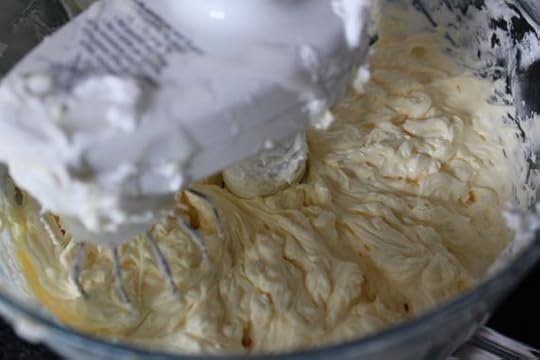 Since the buttercream is coffee-flavored, you’ll need to add a half-espresso, plus 3 tablespoons instant coffee (preferably expresso powder since it will be finer and mix in more smoothly).
Since the buttercream is coffee-flavored, you’ll need to add a half-espresso, plus 3 tablespoons instant coffee (preferably expresso powder since it will be finer and mix in more smoothly).
 Pour the coffee and instant powder into the cream.
Pour the coffee and instant powder into the cream.
 Then mix well and set aside.
Then mix well and set aside.
Step Five. We need a chocolate ganache, because that’s one of the layers in an opéra. Chop up 170 grams of good dark chocolate. I’m pretty sure I used 70%, which is bittersweet.
 Heat up 1/3 cup cream plus 1/2 cup milk. Skim off the yucky stuff.
Heat up 1/3 cup cream plus 1/2 cup milk. Skim off the yucky stuff.
 Pour it over the chocolate bits and stir until it’s all melted.
Pour it over the chocolate bits and stir until it’s all melted.
 Mix in 20 grams of butter and ganache is done.
Mix in 20 grams of butter and ganache is done.
Step Six. Actually, you can do this step when the entire pâtisserie is assembled and has been refrigerated for an hour. But let’s give the instructions now – it’s for the chocolate glaze on top. Melt 400 grams of sweet dark chocolate (52%), 50 grams of margarine and 50 grams of peanut oil.
 And here is the other area where I botched it. I microwaved the chocolate too long and it became thick. A glaze is supposed to be runny, but mine was not.
And here is the other area where I botched it. I microwaved the chocolate too long and it became thick. A glaze is supposed to be runny, but mine was not.
 I added a little more oil and kept stirring, but it was not the thin glaze I needed and I had no time to run out and get more because I was serving the opéra that same evening. The chocolate was as thick as all the other layers when I spread it on, and it had hardened so that it was top-heavy and not easy to cut.
I added a little more oil and kept stirring, but it was not the thin glaze I needed and I had no time to run out and get more because I was serving the opéra that same evening. The chocolate was as thick as all the other layers when I spread it on, and it had hardened so that it was top-heavy and not easy to cut.
Lesson learned? Don’t overheat your chocolate glaze. You should be able to pour it over the opéra, without needing to spread it.
ASSEMBLY TIME !!!!
I bought a pan with removable sides, but this recipe called for a huge 40×30 cm rectangle, and mine was much smaller. What you can do is to assemble your opéra without the sides, and when the entire thing is assembled, cut off the four edges so it looks clean. What I did was to cut the cake to size, like so
 which is all well and good because I can use the pan that I bought. But the problem is, the quantity of cream and chocolate is too much for the size pan I have so all the layers are much thicker than they are supposed to be. Actually, all the layers should be quite thin. So I recommend assembling your opéra on a simple baking sheet (or the correctly sized pan with removable sides).
which is all well and good because I can use the pan that I bought. But the problem is, the quantity of cream and chocolate is too much for the size pan I have so all the layers are much thicker than they are supposed to be. Actually, all the layers should be quite thin. So I recommend assembling your opéra on a simple baking sheet (or the correctly sized pan with removable sides).
Place a piece of wax paper first, then one layer of cake, which you can now soak with 1/3 of the coffee syrup mixture.
 Spread half of the buttercream over your cake layer.
Spread half of the buttercream over your cake layer.
 Like so:
Like so:
 Put a second piece of cake (see how mine broke here? That was from soaking it with coffee overnight. But you should brush the coffee syrup on now).
Put a second piece of cake (see how mine broke here? That was from soaking it with coffee overnight. But you should brush the coffee syrup on now).
 And then pour and spread your entire layer of ganache.
And then pour and spread your entire layer of ganache.
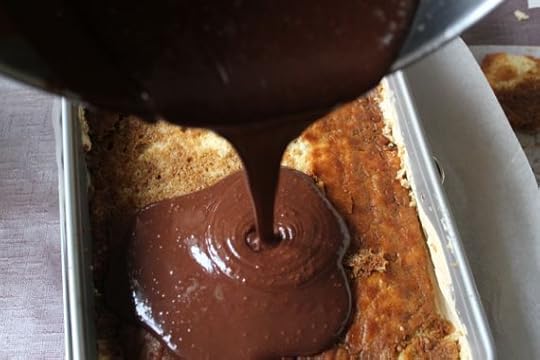 Til it hides the defects.
Til it hides the defects.
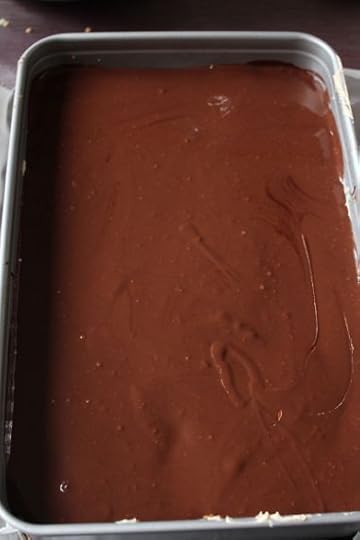 Place the third piece of cake (and brush/soak with coffee).
Place the third piece of cake (and brush/soak with coffee).
 And add the rest of your coffee buttercream.
And add the rest of your coffee buttercream.
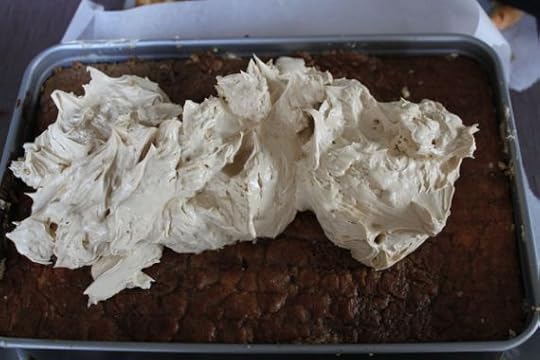 Seriously. Is this not a work of art?
Seriously. Is this not a work of art?
 Into the refrigerator for at least an hour.
Into the refrigerator for at least an hour.
Aaand . . . here’s where it all starts to fall apart.
 I had no idea the buttercream would get so hard. (Duh - right? It’s butter!) Make sure you dip a knife in hot water and separate the buttercream before removing the sides to the cake pan, if you happen to be using one like I did.
I had no idea the buttercream would get so hard. (Duh - right? It’s butter!) Make sure you dip a knife in hot water and separate the buttercream before removing the sides to the cake pan, if you happen to be using one like I did.
 But chocolate covers over a multitude of broken buttercream layers.
But chocolate covers over a multitude of broken buttercream layers.
 Especially when it’s as thick as cement. (Ahem).
Especially when it’s as thick as cement. (Ahem).
In the end it doesn’t matter. Everyone agreed that it tasted ah-MAZ-ing, no matter how it looked.
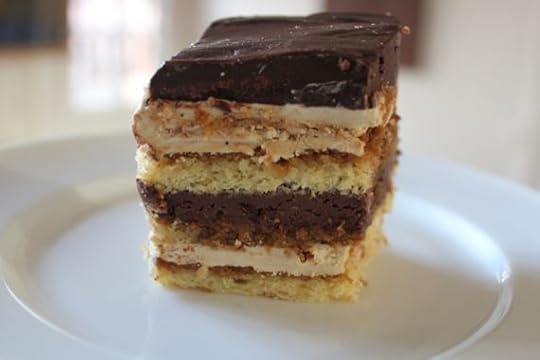 And if you have the patience for it, you too can wow your friends with a little French opéra. And it will be even more gorgeous than mine. I just know it.
And if you have the patience for it, you too can wow your friends with a little French opéra. And it will be even more gorgeous than mine. I just know it.

L’opéra
Prep time
14 hours
Cook time
2 hours
Total time
16 hours
A multi-layered cake with chocolate, espresso and buttercream.
From: Lady Jennie
Recipe type: Dessert
Cuisine: French
Serves: 16
Ingredients
Cake for pan 40×30 cm:
1 cup of eggs (220 g)
5 large egg yolks (80 g)
2.5 cups ground almonds (220 g)
1 cup – (minus) 1 Tablespoon sugar (175 g)
3 large egg whites (125 g)
½ c sugar to mix with egg whites (100 g)
1 cup flour (100 g)
Coffee Syrup:
1¾ cups filtered coffee (400 ml)
¾ cup sugar (150 g)
3 Tablespoons instant coffee (10 g)
Italian Merengue for the Buttercream:
3 T water (40 g)
½ cup sugar (100 g)
2 large egg whites (70 g)
¼ cup sugar to mix with egg whites (35 g)
Buttercream:
5 large egg yolks
1 cup + 1 T sugar (200 g)
½ cup – (minus) 1 T water (100 g)
2 cups butter (450 g or 4 sticks)
The Italian Merengue needs to go in, of course
½ espresso (mini cup)
3 T instant coffee, finely ground (10 g)
Chocolate Ganache:
170 grams dark chocolate
½ cup milk (120 g)
⅓ cup cream (40 g)
1.5 T butter (20 g)
Chocolate Glaze:
400 g dark chocolate 52%
3.5 T margarine (50 g)
4 T peanut oil (50 g)
Instructions
Step One: The cake
Preheat the oven to 200°C (400°F) and line 3 baking sheets with wax paper.
Mix the eggs (1 cup), sugar, egg yolks and almond powder for 15 minutes.
Beat the egg whites with the smaller amount of sugar listed, then combine the two.
Add the flour and stir well, but not with an electric mixer.
Spread an equal amount of batter on all three baking sheets and bake for 10-12 minutes each. Be careful though – my oven is hot so I needed to reduce the temperature and bake them for less time.
After they cool, put them in the fridge with wax paper in between and cover them with saran wrap overnight.
Take out the 2 cups of butter and let it sit out overnight.
Step Two: The Italian Mrengue
Heat the water and sugar until it reaches 114°C.
At that point start mixing the egg whites and sugar until stiff.
When the water/sugar mix reaches 118°C exactly, take it off the heat and pour it slowly into the egg whites while they are mixing.
Set aside.
Step Three: The Coffee Buttercream
Do the same thing with the larger amount of water and sugar – cook it until 118°C.
Beat the egg yolks and add the sugar mix slowly until incorporated, and until the yolks start to form ribbons.
On the side, beat the softened butter, and then add that to the yolks.
Add the merengue and beat that in.
Finally, add the coffee and beat that. It’s done.
Step Four: The Ganache
Chop up the chocolate.
Heat the milk and cream.
When the milk is hot, pour it over the chocolate and stir it until it all melts.
Add the butter and mix it. The ganache is done.
Step Five: Make the coffee syrup for the cakes.
Take the filtered coffee, and add the sugar and instant powder.
Put that aside with the pastry brush and get ready to soak the cakes.
Step Six: The Assembly.
Place a piece of wax paper on the baking sheet, followed by the first cake layer.
Brush a third of the coffee syrup on it until it’s soaked and brown.
Put half of the coffee buttercream.
Put another cake layer and soak with another third of coffee syrup.
Pour all of the ganache on top of that.
Put the third cake layer and soak with the remainder of the syrup.
Top that with the rest of the buttercream.
Put it in the refrigerator for at least an hour.
Step Seven: The chocolate glaze and finishing touch
Heat, but don’t overheat the chocolate, oil and margarine. It should be quite runny.
Take your opéra out of the fridge, and if you’ve used a pan with sides, separate the hardened buttercream from the side of the pan with a hot knife.
Pour the glaze over the top of the opera and use a metal spatula to smooth it over.
Step Eight: Serving the opéra
Keep your opéra in the refrigerator for the entire day, but take it out about an hour before you wish to serve. This will help the buttercream to soften and make the whole thing easier to cut. You can cut small pieces because it’s quite rich.
And you might possibly wish to skip serving coffee with it if you ever hope to get any sleep.
3.2.1263
The post Step-by-Step Instructions for Making an Opéra appeared first on A Lady In France.



